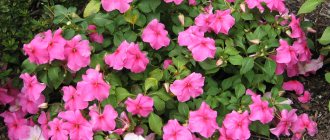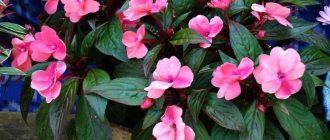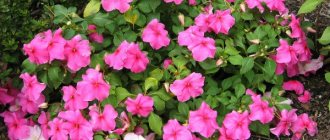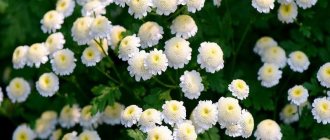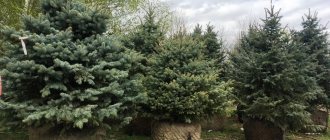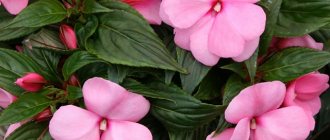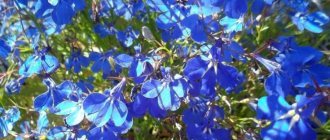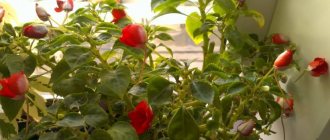Botanical description and history
New Guinea hybrids first appeared on the flower market in 1972. They were bred by crossing the Indonesian variety Hawker with other types of balsam. New Guinea balsam is native to the subtropics and tropics of Africa, Asia and America.
Depending on the place of growth and variety, the flower grows from 30 to 50 cm. The root system is strong and grows well. The plant has the appearance of a bush with many stems .
For oblong-oval pointed leaves:
- bright veins;
- serrated edges;
- short petioles.
Flowers with curly petals can reach a size of 5-7 cm. Depending on the variety, they are one-color or two-color with patterns. At the top of the stems there is one or several buds. Flowering continues for several months, this is influenced by climatic conditions and place of growth.
In place of the flower, a fruit is formed - an oblong capsule . Its outer part is divided by ribs. Once the fruit is ripe, it opens when touched, releasing the seeds. In nature, a flower reproduces this way.
Dates for sowing balsam seedlings in 2022
When is the best time to sow balsam seeds for seedlings in 2022? It is better to plant flower crops in the second half of March and early April . This time is relevant for all varieties and types of garden plants (Waller, Tom Thumb, New Guinea and others), including hanging ones.
However, due to different weather and climatic conditions, sowing dates may vary: in the South you can plant in the middle or even at the beginning of March, in the middle zone (including the Moscow region) it is optimal to plant at the end of March, in Siberia, the Urals, In the Leningrad region it is better to sow in early April.
The timing of planting garden balsam can also be determined according to the Lunar calendar of 2022:
- Favorable days: in January: 1, 10, 11, 15, 16, 19, 20;
- in February: 7, 8, 12, 13, 14, 15;
- in March: 10, 11, 15, 20, 21, 24, 25.
- Unfavorable days: in January: 2, 18th;
- in February: 1, 16;
- in March: 2, 16, 17, 18, 31.
Description of appearance and features
At home, New Guinea balsam can bloom for 10 months. Among gardeners, this property makes the plant very popular.
New Guinea hybrids are distinguished by their power and meatiness . They have strong shoots, bright asymmetrical flowers and very densely spaced leaves. Of the numerous varieties of balsams, these stand out for the beauty of their blooms and the richness of their greenery.
The peculiarities of varietal New Guinea balsam include the fact that the plant sheds its leaves due to:
- hypothermia;
- lack of lighting;
- drying out of the soil.
How the flower will bloom is influenced by the choice of pot, as well as the systematic introduction and composition of fertilizers.
New Guinea hybrids are valued for their colors . Flowers come in different shades:
- pink;
- apricot;
- peach;
- pastel;
- fuchsia, etc.
In addition to the bright dark green color, the leaves are bronze or have a yellowish discoloration in the middle.
Camellia
When favorable conditions are created, the plant grows up to a meter. It harmoniously forms the back parts of alpine slides or complements mixborders.
Provided that the seedlings are not damaged by frost after planting and during care, the Camellia balsam bush will delight with long-lasting flowering and large double flowers, see photo. It will stand out significantly among other garden plants.
Photo
Next in the photo you can look at the plant and admire the beauty of its flowering.
There are more than 400 types of balsam in nature, but in the Northern Hemisphere the following varieties are common: Garden, Wild, Zheleznokosny or Zhelezisty, Tom Samb, as well as Waller's balsam. Flower growers love to grow double and hanging plant species - they will decorate any area or apartment.
Problems in growing New Guinea balsams
In their tendency to spread root rot, New Guineans are no different from other balsams. But the risk of damage only occurs as a result of improper watering. But pests, especially thrips and red spider mites, can appear on the plant both in the vicinity of infected plants and in the fresh air in the heat. It is very difficult to fight them; they quickly lead to damage to the appearance of leaves and flowers. It is believed that it is easier to throw away balsam than to fight insects.
Landing
Can the plant be planted in the garden?
New Guinea balsam is one of the easiest plants to care for , both on the windowsill in the apartment and in the garden. It can withstand short drying and waterlogging of the soil.
Important! It must be borne in mind that in this case the decorative effect of the flower, the density of the leaves and the number of developing buds suffer.
Lighting and location
New Guinea balsam prefers soft, diffused light . It should not be exposed to direct sunlight. The best location for the flower is the window sills facing west and east. In winter, when daylight hours become shorter, the plant requires additional lighting. Otherwise, its shoots will stretch out and the leaves will begin to fall off.
Soil requirements
The flower grows well in light, fertile soil. You can purchase a ready-made substrate or prepare it yourself by mixing:
- Fertile soil.
- Leafy soil.
- Peat.
- Humus.
- Sand.
The self-prepared mixture must be disinfected.
Flower care at home
How to care for a flower?
For normal growth at home, indoor New Guinea balsam requires certain care. The temperature should be 18°C…24°C . The flower has a negative effect:
- temperature below 10 °C;
- frosty air;
- drafts.
Therefore, it should not be placed on the windowsill in the kitchen, because there the windows are often opened for ventilation.
The plant needs to be watered regularly, abundantly, but only after the top layer of soil has dried. This will prevent rot from appearing. In winter, watering is reduced to twice a month , the water flowing into the pan should be poured out.
These plants come from the tropics with high humidity, so when the air is dry they can drop buds and flowers.
Regular spraying will help create optimal humidity in the room, with the exception of flowers and buds.
This procedure is especially necessary in extreme heat and with the onset of the heating season. The leaves of the flower can be wiped with a damp sponge, thereby removing the layer of dust and allowing them to breathe freely.
Abundant flowering is impossible without feeding. Twice a month, New Guinea balsam is fertilized with mineral compounds with potassium. This element contributes to the formation of flowers. There is no need to feed with pure nitrogen, due to which the green mass will actively grow and flowering will slow down.
New Guinea balsam does not tolerate pruning . If you want the bushes to look denser and more compact, you can pinch the tops of the shoots. Although the plant itself is able to form a magnificent shape. To create the appearance and shape of the bush, pruning of only the Harmony type is allowed.
The flower must be replanted once every 2-3 years. This is done in the spring. You need to take a small pot, both in diameter and depth. In cramped conditions, New Guinea balsam will grow more luxuriantly. At the bottom, arrange a drainage layer, for example, from expanded clay. The flower must be carefully transferred from pot to pot. Fill the resulting void with soil to such a level that the root neck rises 2 cm above it.
Homeland of the plant
The name of balsam in Latin is identified as “impatient”, because the fruits, when ripe, crack and scatter over a fairly large distance.
Modern markets in Europe at the end of spring are filled with New Guinea hybrids that look like small bushes with splashes of rich colors.
Hawker's impatiens is the main ancestor of this species. It is a perennial plant native to Indonesia. Crossing was carried out with other abundantly flowering species. In countries that have a temperate continental climate, this species, bred in Guinea, is an annual.
The development of this culture occurred as a result of the active work of employees of the Israeli company Danziger. The first results of the breeders' activities looked like large-flowered compact plants. Moreover, their flowers were of different shades and abundantly covered the bushes. Now the varieties differ both in the shade of flowers and leaves, and in the size and height of the hybrids.
Common diseases and pests
In most cases, New Guinea balsam gets sick from improper care. This is evidenced by the external state of its parts. When exposed to direct sunlight, yellow spots appear on the leaves. This means that the flower has received burns.
It happens that when the heating is turned on, balsam leaves begin to :
- let the edges dry;
- wither;
- fall off
You need to install special trays with water and expanded clay or install a humidifier. If the always colorful leaves turn pale, this indicates a lack of nutrients. The application of complex fertilizers will help them become bright again.
The following leads to rotting of the root system and stems of New Guinea balsam, and subsequently to fungal diseases:
- excessive watering;
- soil waterlogging;
- too damp air.
The flower can suffer from insect pests: aphids and spider mites. Infected New Guinea balsam must be isolated. Treatment is carried out with special drugs. They treat the flower itself and the ground.
Useful tips from experienced gardeners
In order not to make mistakes out of ignorance, you should listen to the advice of experienced flower growers. Years of experience are invaluable and help eliminate mistakes:
- in the summer, you should worry about drip irrigation so as not to irrigate the leaves and deliver water directly to the root;
- Flowering plants need to be fed twice a month;
- if you cut off the tops of the bushes, the branches will begin to throw out shoots - flower stalks;
- To prevent the appearance of aphids and whiteflies, flowers should be treated monthly with protective drugs.
Garden balsam is a worthy, attention-grabbing decoration for a personal plot. By devoting a little time to growing in the spring, you can enjoy its luxurious splendor until the first autumn frosts.
Features of reproduction
Under natural conditions, balsam propagation occurs using seeds. It is difficult to grow a flower at home this way.
Seeds
According to statistics, out of 10 sown seeds, only 5 germinate. You must also keep in mind that young plants obtained from seeds develop slowly ; the slightest reason can lead to their death.
First you need to prepare fertile soil on which to carefully spread the seeds. After this, sprinkle them with a small layer of earth. Then moisten using a spray bottle or watering can with a spray bottle.
All this must be covered with a transparent film or glass to create a greenhouse effect. It is necessary to systematically open the container to ventilate and moisten the soil, preventing the earthen clod from drying out. The appearance of the first shoots can be expected in 1.5-2 weeks.
Cuttings
The most effective method of propagating New Guinea balsam is cuttings. To do this, below the node, you need to cut off the stalk on which you want to remove the lower leaves. Plant it in prepared soil. It is necessary to place the cutting in a warm place where there is no draft and where direct sunlight does not penetrate. Roots form after 14 days .
In indoor conditions, New Guinea balsam lives for 4-5 years, then it needs to be renewed. When grown in open ground, the plant becomes an annual.
Impatiens is a flower that, although it does not smell, stands out for its magnificent blooms. It is widely used in landscaping personal plots. With the help of New Guinea balsam flowers of different colors, landscape designers create picturesque and unique compositions.
If you find an error, please select a piece of text and press Ctrl+Enter.
Popular varieties
There are many varieties of New Guinea balsam, but some are particularly decorative. Since the selection work is very active, not even specific varieties are identified, but varietal groups. They have common features, but may differ in flower color.
Representatives of the variety are distinguished by their compact bush, rich green leaf color and small flower size.
A distinctive feature of the variety is the orange or salmon hue of the flowers. They look especially decorative against the background of green foliage with a hint of bronze.
The color of the flowers is always bright shades, the foliage is dark green. There are specimens with two-color petals.
All representatives of the varietal group are distinguished by their compact bush shape. Belongs to the large-flowered varieties. Petals can have different colors.
The color of the flowers contains only delicate pastel tones. The leaf blade is glossy, dark green.
The main feature is the reddish tint of the leaf blade in some varieties. The flowers are round in shape and small in size.
The small size of the variety's flowers fully compensates for their number. During flowering, the compact bush is almost completely covered with them.
The original variegated variety. The flowers are snow-white in color and have medium-sized petals.
